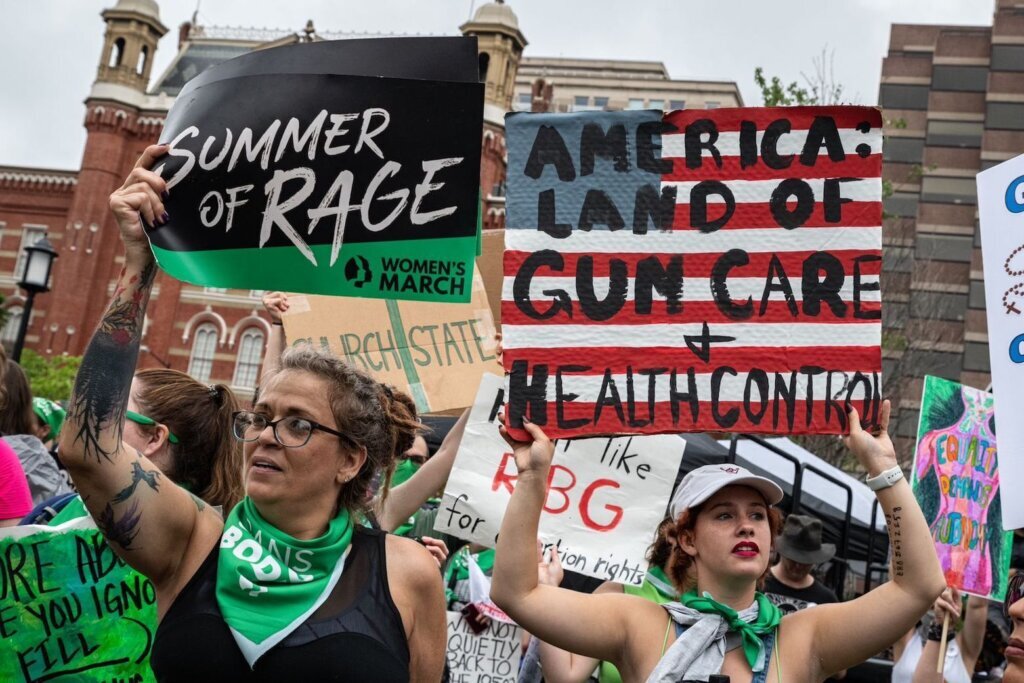
Demonstrators with the Women’s March risked arrest in D.C. amid stormy weather Saturday outside the White House in an action meant to pressure President Joe Biden’s administration to do more to protect abortion rights.
See a timeline of events below as they unfolded.
2:00 p.m.
Most of the group that had been sitting outside the White House perimeter, including those who had previously tied themselves to the fence, have left the area and headed back to Franklin Park.
WTOP’s Alejandro Alvarez said that police presence had also dwindled and he observed no arrests during the march and subsequent sit-in. Many of the bandanas tied to the White House’s north fence remained as the demonstrators marched away.
1:30 p.m.
Around 1:30 p.m., WTOP’s Alejandro Alvarez reported that the north fence of the White House was covered in “hundreds” of green bandanas.
It’s a “hectic situation,” Alvarez said, as hundreds of people marched into the sidewalk area outside of the White House and tied the bandanas bearing the slogan “bans off our bodies” on the north fence.
Alvarez reported U.S. Secret Service officers had been watching a pair of demonstrators that had physically tied themselves to the fence, but took no action.
Mass sit-in at the White House fence. Hundreds joining despite the rain. People tying their green bandanas reading “bans off our bodies” on the north fence itself before taking a seat on the sidewalk. pic.twitter.com/kbPtC6q2Z6
— Alejandro Alvarez (@aletweetsnews) July 9, 2022
At one point, Secret Service biked up to the fence and tried to untie bandanas, but quickly “seemed to have given up on doing that,” Alvarez said.
As Saturday’s heavy rains continued to pour, several hundred demonstrators remained seated on the sidewalk, chanted “my body, my choice”, Alvarez said.
12:30 p.m.
Protesters could be heard chanting “our house, our streets” as they prepared to move towards the White House.
Around 11:30 a.m., more than 1,000 people were already gathered in a muddy area of Franklin Square Park in D.C. Before the march began, many were dancing and chanting. Anticipating possible arrests, organizers printed out hundreds of jail support forms and handed them out to those in the group.
Big crowd of abortion rights supporters with the Women’s March headed to the White House where they’re planning to risk arrest at the north fence. Organizers demand Biden use his power “to the limit” to safeguard abortion access nationwide. pic.twitter.com/NHWPXwUg2C
— Alejandro Alvarez (@aletweetsnews) July 9, 2022
Women’s March Executive Director Rachel O’Leary Carmona spoke to the crowd as they prepared to move, leading them in a chant of “ungovernable,” and calling today’s actions a continuation of their “summer of rage” in support of abortion rights.
Carmona told the crowd she knows there’s a limit to President Biden’s authority, but wants him to “push his authority to the limit.”
10:00 a.m.
“We will not be silent. We will not be ignored. And we will not let politicians play games with our lives and our futures,” read an invite on the Women’s March website. “If our leaders won’t take action, we will.”
Up to 1,000 people are expected to attend, according to a public gathering permit from the National Park Service, although not all will risk arrest.
The Women’s March will rally in Franklin Square from about 10 a.m. to noon, before heading to Lafayette Square for what the permit described as “a free speech demonstration calling for increased access to abortion and a rejection of the overturn of Roe v. Wade.”
Rachel O’Leary Carmona, executive director of the Women’s March, called the plan a more targeted and escalated one than the mass rallies the group has garnered a nationwide reputation for.
But the protesters are now strangers to civil disobedience, or what the activism community terms “direct action” — in June 2018, the Women’s March led hundreds to risk arrest in downtown D.C. protesting family separation at the border.
“The purpose of the action is to encourage President Biden to continue to take executive action, to protect abortion rights, and to use the bully pulpit to move the party to do the same thing,” Carmona told WTOP.
Carmona said she will be among those risking arrest on the White House’s north sidewalk, along with other Women’s March leaders and abortion rights supporters.
Saturday’s mass action comes two months after a leaked Supreme Court draft opinion spurred thousands to demonstrate in support of abortion rights.
“Today is Day One of an uprising to protect abortion rights, it is Day One of our feminist future and it is Day One of a summer of rage where we will be ungovernable,” Carmona told a large crowd under the Washington Monument on May 14.
“We will not stop until the politicians start acting like they’re on our side, and we will not stop until the politicians who claim to fight for women actually fight for us.”
The National Mall, where thousands of abortion rights supporters are rallying before a march down Constitution Avenue and onto Capitol Hill. A Women’s March organizer calls it “Day One of a summer of rage,” leading the crowd in chants of “ungovernable.” pic.twitter.com/7EvUjNyttG
— Alejandro Alvarez (@aletweetsnews) May 14, 2022
With the overturning of Roe v. Wade on June 24, abortion rights supporters have kept up their presence outside the Supreme Court building, Senate offices and the D.C. region homes of conservative justices — but on Saturday, it’ll be the Biden administration demonstrators will plead with to safeguard under federal law what was formerly protected under Roe.
Under mounting pressure from fellow Democrats to be more forceful in response to the ruling, President Joe Biden on Friday signed an executive order to try to protect abortion access. The actions Biden outlined are intended to head off some potential penalties that women seeking abortion may face after the ruling, but activists are pressing him to go further.
“We told them that just waiting until November was not an option. Today’s actions are a direct result of that pressure, but make no mistake: allies should not have to be bullied into being proactive,” Carmona said in a statement. “In a dangerous moment like this, timing is everything. The executive actions being undertaken are needed first steps, but it’s not nearly enough.”
WTOP’s Shayna Estulin and The Associated Press contributed to this report.









